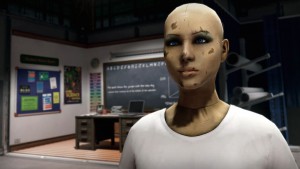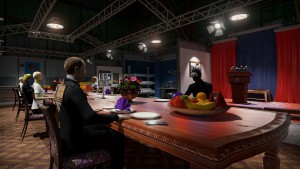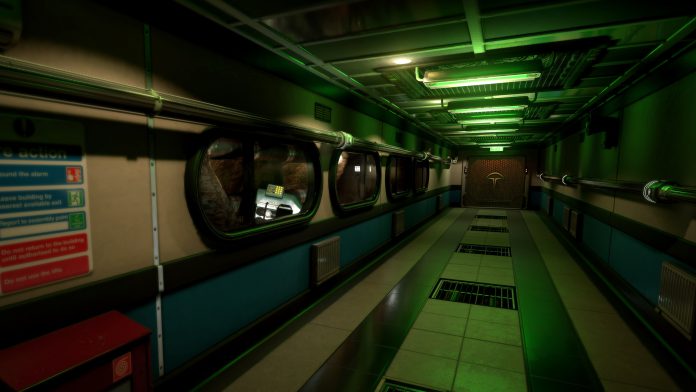Last week saw the announcement of The Assembly‘s release date and pricing, along with an addition to the few videos nDreams has posted concentrating on the different areas of development within the videogame. These videos have provided a more in-depth look, but now VRFocus has a one-on-one, or more one-on-five, talk with the development team.
I had the chance to sit down with a group of some of the main creators and influencers at nDreams to talk about The Assembly, and when the conversation started up, George Kellion, Community Manager at nDreams, was eager to know whether or not I enjoyed The Assembly. The first point I brought up after playing was the choice of locomotion, and that although it was encouraged that the teleportation, or blink, mode of walking should be used to avoid motion sickness, I enjoyed free-roam walking without feeling much sickness too.
Jackie Tetley, Sr Game Designer, stepped in and explained “You haven’t got a formula for what people are going to find the most comfortable so we just wanted to offer a couple of solid good choices and a few variations to let people find their feet. Maybe people will decide to switch between the two, I really don’t know.”
Richard Fabian, Code Dept. Manager, also added that “we put our research into it and we thought last year that it would be a good idea to give it a go. We also had to redesign some of the game around it as it brought up issues of getting to places fast enough. The research showed that the numbers of people who were much more comfortable using this system was amazing. We were hitting the high 90s for people saying “yeah I can play the game with no problem”, and now we are happy to announce we have the perfect introduction into VR.”
Fabian brought up a more than valid point, referring back to when the move into 3D videogaming triggered sickness in gamers, but since then there has been a combination of improved graphics and tolerance for it that has resulted in progress towards more advanced technology: “I remember back in the mid-80s when they started doing the scan line style, 3D style, and people started to feel sick even on Wolfenstein. These things change.”
I posed the developers the question of what they had progressed with the most leading up to this penultimate stage before the launch of The Assembly, to which Tetley answered with much certainty: “We put a lot of time in the narrative and the story, honing that as much as possible, especially the art.” This is where Martin Field, Art Manager, called out “This is my bit!”
Field accredited a fair amount of his area’s advancements to the support of the technology that was used in order to create the title: “There has been a lot of advancements in the headset’s SDKs allowing us more what we can work with, and the actual support we’ve had from the engine makers such as Unreal and Unity, they’ve put their own focus on VR themselves. So, a lot of material uses and optimisations we can get from those really helped us with the visuals of the game as well to support the increased narrative.”
“The sound is really amazing, too” Tetley added.

Fabian explained what the team had achieved when it came to the audio of the videogame: “That’s all come together since the last demo. There’s a lot of spatial recognition going on. You can close your eyes and sense where the Assembly is most of the time, and feel things are nearby, above. It really adds and increases the feeling of being there.”
There’s no denying that there has been a fair amount of work made on the audio to the game, but I pointed out that the sound wasn’t quite as ‘stitched’, or smooth, as what it could be when turning corners, and asked if there was more work to be done leading up to the release of the videogame. I directed this towards Matt Simmonds, the Sr Audio Designer.
“With some of the positional, at the minute, there is only so much you can do with the tech. I’m still moving things around as I play the game – if there is something I find doesn’t sound quite right I’ll do it again. It works well in a lot of places.
“I quote this in the same way that ambient lighting was a little bit dodgy when it first came. It was quite an impressive technology, but over the years, especially now you look at a game with proper real-time lighting and you don’t see any blocky-ness – it’s the same with the audio.
“The first ones we had could bearly do more than eight different sources. But now, you’re not really limited by the sources, it’s more about how good quality you want it to be. Soon they will come up with a formula just like with the visuals of the game, and it will soon be that all audio in videogames is binaural and it won’t be a big deal.”
To bring it back to the general gameplay and to direct the conversation at the general populous of the team, the next point raised was of the puzzles within the videogame, and how silly I felt after spending a long time searching for an answer that turned out to be quite obvious when I took time to stop and think. I asked the group how they came to the conclusion to create these puzzles.

Tetley answered first: “We tried to make the game as accessible as we could for players. There’s a fine line between wanting to make it challenging, but also not blocking anyone from experiencing the game and the narrative, and because we are a story-led game, that’s the most important thing. We have sometimes made things a bit more simpler even though I wanted to make it a bit more tricky.”
When asked if there would be more puzzles added, or if the chapters I had tried were complete, Fabian explained that they were completed.
“We don’t want to put too much information into the levels as it’s already in your face with the quantity of stuff, but we have got a lot of content in these small spaces. We don’t want to add too much time as well, we want to make sure people spend 20-30 minutes at most so there is punctuation in this experience.”
Kellion reiterated that they have coined The Assembly as “the perfect introduction to VR”, something that has been repeated a number of times since the more advanced development of the title. “We didn’t want to cause decision paralysis, or that they were being hurried along.”
“Pace was so important to the design,” said Fabian. “As they’re introduced, we don’t know what level of experience they are. With the second play through, and the third, you’re going to have a whole different pace.”
In terms of pace, it can be slowed down a lot from how text-heavy The Assembly can be. I did question how immersive this technique was in the light of playing a videogame – this is meant for entertainment, and it could pose as an obstacle for those who don’t want to scroll through walls of text (despite it being optional). Fabian and Tetley both agreed that this was the most realistic way for the player to obtain knowledge that they weren’t necessarily there to get, and they wanted to avoid the cliche of overhearing unrealistically loud conversations that tell you everything. “You’ve got to remember, we’re in VR,” began Fabian. “We can’t use cut scenes to present more easily digestible snippets of information. We have to place it to be discovered.”
How could this title justify itself as being perfect for VR when you could get the same sort of gameplay out of a ‘rectangular’ piece? Fabian took the chance to jump on this topic: “It’s the emotional application. The use of this, which makes it more immersive, gives us a chance to have a more nuanced approach to storytelling. Getting the characters reveal more cleverly with little alerts – you can pick it up better in VR than you would in a 2D game. There’s a little love tale that you would have thought would be a throwaway maybe in another environment, but the fact that you’re actually in there makes it hit you harder.”
Kellion backed up Fabian with a few teasing comments with regards to how the game will develop: “I guess the main thing that we do, as Fabs (Fabian) says, is leverage curiosity, because later on in the game there is a character who absolutely does not turn out to be who you think it is when you first come across them, and that is a surprise that I think works a lot better in VR.” This causes the room to stop and laugh with Tetley saying “you’re trying to choose your words to carefully!”
Before any vital information could have been accidentally revealed during the conversation, the team wrapped up the interview pretty swiftly. All will be revealed when the title releases on 19th July for Oculus Rift and HTC Vive, with the PlayStation VR version to follow later this year.















